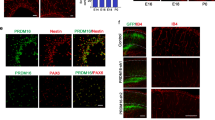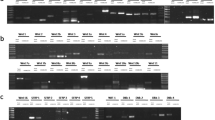Abstract
The blood-brain barrier (BBB) is essential for maintaining brain homeostasis and low permeability. BBB maintenance is important in the central nervous system (CNS) because disruption of the BBB may contribute to many brain disorders, including Alzheimer disease and ischemic stroke. The molecular mechanisms of BBB development remain ill-defined, however. Here we report that src-suppressed C-kinase substrate (SSeCKS) decreases the expression of vascular endothelial growth factor (VEGF) through AP-1 reduction and stimulates expression of angiopoietin-1 (Ang-1), an antipermeability factor in astrocytes. Conditioned media from SSeCKS-overexpressing astrocytes (SSeCKS-CM) blocked angiogenesis in vivo and in vitro. Moreover, SSeCKS-CM increased tight junction proteins in endothelial cells, consequently decreasing [3H]sucrose permeability. Furthermore, immunoreactivity to SSeCKS gradually increased during the BBB maturation period, and SSeCKS-expressing astrocytes closely interacted with zonula occludens (ZO)-1-expressing blood vessels in vivo. Collectively, our results suggest that SSeCKS regulates BBB differentiation by modulating both brain angiogenesis and tight junction formation.
This is a preview of subscription content, access via your institution
Access options
Subscribe to this journal
Receive 12 print issues and online access
$209.00 per year
only $17.42 per issue
Buy this article
- Purchase on Springer Link
- Instant access to full article PDF
Prices may be subject to local taxes which are calculated during checkout






Similar content being viewed by others
References
Lin, X. et al. Isolation and characterization of a novel mitogenic regulatory gene, 322, which is transcriptionally suppressed in cells transformed by src and ras. Mol. Cell Biol. 15, 2754–2762 (1995).
Gelman, I.H., Tombler, E. & Vargas, J. Jr. A role for SSeCKS, a major protein kinase C substrate with tumor suppressor activitiy, in cytoskeletal architecture, formation of migratory processes, and cell migration during embryogenesis. Histochem. J. 32, 13–26 (2000).
Lin, X., Nelson, P. & Gelman, I.H. SSeCKS, a major protein kinase C substrate with tumor suppressor activity, regulates G(1)—>S progression by controlling the expression and cellular compartmentalization of cyclin D. Mol. Cell Biol. 20, 7259–7272 (2000).
Gelman, I.H. The role of SSeCKS/Gravin/AKAP12 scaffolding proteins in the spaciotemporal control of signaling pathways in oncogenesis and development. Front. Biosci. 7, d1782–d1797 (2002).
Lin, X., Tombler, E., Nelson, P.J., Ross, M. & Gelman, I.H. A novel src- and ras-suppressed protein kinase C substrate associated with cytoskeletal architecture. J. Biol. Chem. 271, 28430–28438 (1996).
Xia, W., Unger, P., Miller, L., Nelson, J. & Gelman, I.H. The src-suppressed C kinase substrate, SSeCKS, is a potential metastasis inhibitor in prostate cancer. Cancer Res. 61, 5644–5651 (2001).
Welsh, J.B. et al. Analysis of gene expression profiles in normal and neoplastic ovarian tissue samples identifies candidate molecular markers of epithelila ovarian cancer. Proc. Natl. Acad. Sci. USA 98, 1176–1181 (2001).
Perou, C.M. et al. Molecular portraits of human breast tumors. Nature 406, 747–752 (2000).
Risau, W. & Wolburg, H. Development of the blood-brain barrier. Trends Neurosci. 13, 174–178 (1990).
Risau, W. Differentiation of endothelium. FASEB J. 9, 926–933 (1995).
Staddon, J.M. & Rubin, L.L. Cell adhesion, cell junctions and the blood-brain barrier. Curr. Opin. Neurobiol. 6, 622–627 (1996).
Petty, M.A. & Wettstein, J.G. Elements of cerebral microvascular ischemia. Brain Res. Brain Res. Rev. 36, 23–34 (2001).
Nag, S. The blood-brain barrier and cerebral angiogenesis: lessons from the cold-injury model. Trends Mol. Med. 8, 38–44 (2002).
Plate, K.H. Mechanisms of angiogenesis in the brain. J. Neuropathol. Exp. Neurol. 58, 313–320 (1999).
Breier, G., Albrecht, U., Sterrer, S. & Risau, W. Expression of vascular endothelial growth factor during embryonic angiogenesis and endothelial cell differentiation. Development 114, 521–532 (1992).
Prat, A., Biernacki, K., Wosik, K. & Antel, J.P. Glial cell influence on the human blood-brain barrier. Glia 36, 145–155 (2001).
Janzer, R.C. & Raff, M.C. Astrocytes induce blood-brain barrier properties in endothelial cells. Nature 325, 253–257 (1987).
Risau, W. Mechanisms of angiogenesis. Nature 386, 671–674 (1997).
Maltepe, E. & Simon, M.C. Oxygen, genes, and development: an analysis of the role of hypoxic gene regulation during murine vascular development. J. Mol. Med. 76, 391–401 (1998).
Lee, Y.M. et al. Determination of hypoxic region by hypoxia marker in developing mouse embryos in vivo: a possible signal for vessel development. Dev. Dyn. 220, 175–186 (2001).
Song, H.S. et al. Oxygen tension regulates the maturation of the blood-brain barrier. Biochem. Biophys. Res. Commun. 290, 325–331 (2002).
Dvorak, H.F., Nagy, J.A., Feng, D., Brown, L.F. & Dvorak, A.M. Vascular permeability factor/vascular endothelial growth factor and the significance of imcrovascular hyperpermeability in angiogenesis. Curr. Top. Microbiol. Immunol. 237, 97–132 (1999).
Liekens, S., De Clercq, E. & Neyts, J. Angiogenesis: regulators and clinical applications. Biochem. Pharmacol. 61, 253–270 (2001).
Yancopoulos, G.D. et al. Vascular-specific growth factors and blood vessel formation. Nature 407, 242–248 (2000).
Pages, G. et al. Signaling angiogenesis via p42/p44 kinase cascade. Ann. NY Acad. Sci. 902, 187–200 (2000).
Alfranca, A. et al. c-Jun and hypoxia-inducible factor 1 functionally cooperate in hypoxia-induced gene transcription. Mol. Cell Biol. 22, 12–22 (2002).
Kniesel, U. & Wolburg, H. Tight junctions of the blood-brain barrier. Cell. Mol. Neurobiol. 20, 57–76 (2000).
Thurston, G. et al. Leakage-resistant blood vessels in mice transgenically overexpressing angiopoietin-1. Science 286, 2511–2514 (1999).
Thurston, G. et al. Angiopoietin-1 protects the adult vascular against plasma leakage. Nat. Med. 6, 460–463 (2000).
Krikun, G. et al. Abnormal uterine bleeding during progestin-only contraception may result from free radical-induced alterations in angiopoietin expression. Am. J. Pathol. 161, 979–986 (2002).
Rubin, L.L. & Staddon, J.M. The cell biology of the blood-brain barrier. Annu. Rev. Neurosci. 22, 11–28 (1999).
Liebner, S. et al. Claudin-1 and claudin-5 expression and tight junction morphology are altered in blood vessels of human glioblastoma multiforme. Acta Neuropathol. 100, 323–331 (2000).
Ebnet K. et al. Junctional adhesion molecule interacts with the PDZ domain-containing proteins AF-6 and ZO-1. J. Biol. Chem. 275, 27979–27988 (2000).
Nico, B. et al. Developmental expression of ZO-1 antigen in the mouse blood-brain barrier. Brain Res. Dev. Brain Res. 114, 161–169 (1999).
Rubin, L.L. et al. A cell culture model of the blood-brain barrier. J. Cell Biol. 115, 1725–1735 (1991).
Wang, W., Dentler, W.L. & Borchardt, R.T. VEGF increases BMEC monolayer permeability by affecting occludin expression and tight junction assembly. Am. J. Physiol. Heart Circ. Physiol. 280, H434–H440 (2001).
Fischer, S., Wobben, M., Marti, H.H., Renz, D. & Schaper, W. Hypoxia-induced hyperpermeability in brain microvessel endothelial cells involves VEGF-mediated changes in the expression of zonula occludens-1. Microvasc. Res. 63, 70–80 (2002).
Dallasta, L.M. et al. Blood-brain barrier tight junction disruption in human immunodeficiency virus-1 encephalitis. Am. J. Pathol. 155, 1915–1927 (1999).
Levy, A.P., Levy, N.S., Wegner, S. & Goldberg, M.A. Transcriptional regulation of the rat vascular endothelial growth factor gene by hypoxia. J. Biol. Chem. 270, 13333–13340 (1995).
Joussen, A.M. et al. Suppression of diabetic retinopathy with angiopoietin-1. Am. J. Pathol. 160, 1683–1693 (2002).
McCarthy, K.D. & de Vellis, J. Preparation of separate astroglial and oligodendroglial cell cultures from rat cerebral tissue. J. Cell Biol. 85, 890–902 (1980).
Radany E.H. et al. Directed establishment of rat brain cell lines with the phenotypic characteristics of type 1 astrocytes. Proc. Natl. Acad. Sci. USA 89, 6467–6471 (1992).
Lisitsyn, N., Lisitsyn, N. & Wigler, M. Cloning the differences between two complex genomes. Science 259, 946–951 (1993).
Lee, M.S. et al. Angiogenic activity of pyruvic acid in in vivo and in vitro angiogenesis models. Cancer Res. 61, 3290–3293 (2001).
Kim, M.S. et al. Histone deacetylases induce angiogenesis by negative regulation of tumor suppressor genes. Nat. Med. 7, 437–443 (2001).
Acknowledgements
We thank K. Kim and J.-H. Park (School of Biological Sciences, Seoul National University, Korea) and M. Kim (College of Medicine, Seoul National University, Korea) for helpful discussions about brain histology. Financial support was from the Vascular System Research Center grant from the Korea Science and Engineering Foundation and the National Research Laboratory Fund (2002-N-NL-01-C-015), and Ministry of Science and Technology, Korea (to K.-W. K).
Author information
Authors and Affiliations
Corresponding author
Ethics declarations
Competing interests
The authors declare no competing financial interests.
Rights and permissions
About this article
Cite this article
Lee, SW., Kim, W., Choi, Y. et al. SSeCKS regulates angiogenesis and tight junction formation in blood-brain barrier. Nat Med 9, 900–906 (2003). https://doi.org/10.1038/nm889
Received:
Accepted:
Published:
Issue Date:
DOI: https://doi.org/10.1038/nm889
This article is cited by
-
New insights into circRNA and its mechanisms in angiogenesis regulation in ischemic stroke: a biomarker and therapeutic target
Molecular Biology Reports (2023)
-
Thinking outside the box: non-canonical targets in multiple sclerosis
Nature Reviews Drug Discovery (2022)
-
Defective Function of the Blood–Brain Barrier in a Stroke-Prone Spontaneously Hypertensive Rat: Evaluation in an In Vitro Cell Culture Model
Cellular and Molecular Neurobiology (2022)
-
Roles of A-kinase Anchor Protein 12 in Astrocyte and Oligodendrocyte Precursor Cell in Postnatal Corpus Callosum
Stem Cell Reviews and Reports (2021)
-
The progress of gut microbiome research related to brain disorders
Journal of Neuroinflammation (2020)



